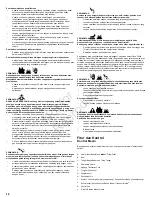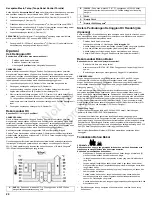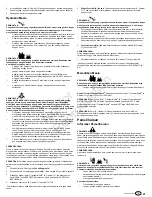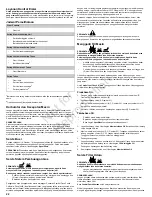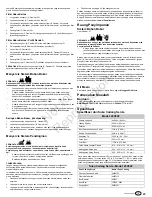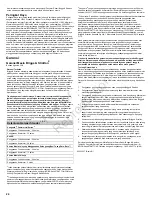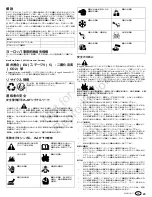
WARNING
POISONOUS GAS HAZARD. Engine exhaust contains carbon monoxide, a
poisonous gas that could kill you in minutes. Although you do not smell exhaust
fumes, you could still be exposed to dangerous carbon monoxide gas. If you feel
sick, dizzy, or weak while you use this product, get to fresh air RIGHT AWAY. See
a doctor. You may have carbon monoxide poisoning.
•
Carbon monoxide gas can collect in occupied spaces. To reduce the risk of
carbon monoxide gas, ONLY operate this product outdoors and far away from
windows, doors and vents.
•
Install battery-operated carbon monoxide alarms or plug-in carbon monoxide
alarms with battery back-up as specified by the manufacturer's instructions.
Smoke alarms cannot sense carbon monoxide gas.
•
DO NOT operate this product in homes, garages, basements, crawlspaces,
sheds, or other closed spaces, even if you use fans or open doors and windows
for ventilation. After the operation of this product, carbon monoxide can quickly
collect in these spaces and stay for hours.
•
ALWAYS put this product downwind and point the engine exhaust away from
occupied spaces.
NOTICE
This engine was shipped from Briggs & Stratton without oil. Equipment manufacturers or
dealers could have added oil to the engine. Before you start the engine for the first time,
make sure that the oil is at the correct level. Add oil as specified by the instructions in
this manual. If you start the engine without oil, damage will occur and the engine will not
be repaired under warranty.
NOTE:
Your equipment could have remote controls. Refer to the equipment manual for
location and operation of remote controls.
1. Check the engine oil. Refer to
Check Oil Level
section.
2. Make sure that the equipment drive controls, if equipped, are disengaged.
3. Move the throttle control lever / TransportGuard
®
(A, Figure 17), if equipped, to the
FAST or RUN position. Operate the engine in the FAST or RUN position.
4. Move the choke control (B, Figure 17) to the CLOSED position.
The choke is usually not necessary when you start a warm engine.
5.
Rewind Start, if equipped:
Tightly hold the starter cord handle (C, Figure 17). Pull
the starter cord handle slowly until resistance is felt, then pull quickly.
WARNING
Fast retraction of the starter cord (kickback) will pull your hand and arm to the
engine faster than you can let go. Broken bones, fractures, bruises or sprains
could result.
• To prevent kickback when you start the engine, pull the starter cord slowly until
resistance is felt and then pull quickly.
• Before you start the engine, disconnect or remove all external equipment and
engine loads.
• Make sure that direct-coupled equipment components, such as, but not limited to,
blades, impellers, pulleys, and sprockets, are correctly attached.
6.
Electric Start, if equipped:
Turn the electric start switch (D, Figure 17) to the
START position.
NOTICE
To extend the life of the starter, use short start cycles (five seconds maximum). Wait one
minute between start cycles.
7. As the engine warms, move the choke control (B, Figure 17) to the OPEN position.
If the engine does not start after 2 or 3 times, contact your local dealer or go to
vanguardpower.com or call 1-800-999-9333 (in USA).
Stop the Engine
WARNING
Fuel and its vapors are flammable and explosive. Fire or explosion could result in
burns or death.
•
Do not choke the carburetor (if equipped) to stop the engine.
Throttle Control / TransportGuard
®
:
Move the throttle control / TransportGuard
®
(A,
Figure 18) to the OFF or STOP position.
NOTE:
When the throttle control / TransportGuard
®
or STOP position, the fuel valve is in the OFF position. Always move the throttle
control / TransportGuard
®
to the OFF or STOP position during transport of the
equipment.
NOTE:
The key (D, Figure 18) does not stop the engine. The key ONLY starts the
engine. Always remove the key (D), and keep it in a safe location out of reach of
children.
Maintenance
Maintenance Information
WARNING
During maintenance if it is necessary to tilt the unit, make sure that the fuel tank, if
mounted on the engine, is empty and that the spark plug side is up. If the fuel tank is not
empty, leakage can occur and could result in a fire or an explosion. If the engine is tilted
in a different direction, it will not easily start because of oil or fuel contamination of the air
filter or the spark plug.
We recommend that you see a Briggs & Stratton Authorized Service Dealer for all
maintenance and servicing of the engine and engine parts.
NOTICE
All the components used to build this engine must remain in place for correct operation.
WARNING
Accidental engine spark can cause an electric shock or fire and could result in
entanglement, traumatic amputation or laceration.
Before you make adjustments or repairs:
•
Disconnect the spark plug wire and keep it away from the spark plug.
•
Disconnect the battery wire from the negative battery terminal (only engines with
electric start.)
•
Use only the correct tools.
When you check for spark:
•
Use an approved spark plug tester.
•
Do not check for spark with the spark plug removed.
Emissions Control Service
For maintenance, replacement, or repair of emissions control devices and
systems, contact a qualified off-road engine repair establishment or service
technician.
However, for "no charge" emissions control service, the work must be done
by a factory authorized dealer. Refer to the Emissions Control Statements.
Maintenance Schedule
First 5 Hours
•
Change the oil.
Intervals of 8 Hours or Daily
•
Check the engine oil level.
•
Clean the area around the muffler and controls.
•
Clean the air intake grille.
Intervals of 100 Hours or Annually
•
Service the exhaust system.
Intervals of 200 Hours or Annually
•
Change the engine oil.
•
Clean the air filter
1
Intervals of 600 Hours or 3 Years
•
Replace the air filter.
Annually
•
Replace the spark plug.
•
Service the fuel system.
•
Service the cooling system
1
.
•
Check the valve clearance
2
.
1
Clean more frequently in dusty conditions or when many particles are in the air..
10
Not for
Reproduction
Summary of Contents for 25V000
Page 2: ...1 2 3 4 5 6 2 N o t f o r R e p r o d u c t i o n...
Page 3: ...7 8 9 10 11 12 13 3 N o t f o r R e p r o d u c t i o n...
Page 4: ...14 15 16 17 18 19 20 21 22 4 N o t f o r R e p r o d u c t i o n...
Page 5: ...23 24 25 26 27 5 N o t f o r R e p r o d u c t i o n...
Page 73: ...N o t f o r R e p r o d u c t i o n...
Page 74: ...N o t f o r R e p r o d u c t i o n...


















